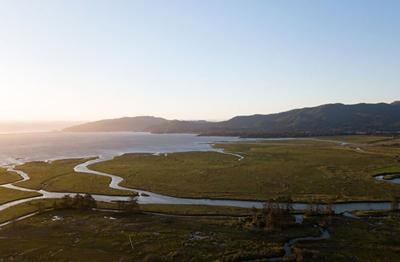THE DALLES — Wasco County commissioners have voted to oppose a federal plan that would tie flood insurance eligibility to habitat protections for endangered salmon species and orcas, saying the proposal could severely limit development and penalize property owners across flood-prone areas of the county.
At their Oct. 1 meeting, the county board unanimously approved a public comment letter urging the Federal Emergency Management Agency’s (FEMA) to withdraw its integration of the proposed endangered species protections into the National Flood Insurance Program (NFIP).
“While we understand FEMA’s obligations under the Endangered Species Act, these obligations cannot be shifted to Wasco County at such astounding and unsustainable costs,” the letter reads. “The economic and social wellbeing of our citizens depends on a plan reasonable and technically and economically feasible.”
Planning Director Daniel Dougherty told the board that his department identified properties in Tygh Valley, Wamic and Pine Grove, 10 commercial and 29 residential, impacted by these new standards. With the proposed building codes, new construction costs on these properties would increase up to 28.8%, according to estimates from FEMA.
In recent years, very little building has been sought on Wasco County properties within flood zones. Dougherty told Columbia Gorge News in an email that the planning department has received two applications for building permits in the flood zone within the past five years: one was approved, the other withdrawn.
Since requiring Wasco County to adopt pre-implementation compliance measures last summer, FEMA has issued a draft Environmental Impact Statement offering three options:
● Alternative 1: “No change.” The NFIP would remain focused on human and property protection, with no ESA integration.
● Alternative 2: Adds a “no net loss” requirement for floodplain function but allows exemptions for projects that have already undergone ESA review.
● Alternative 3: Enforces full ESA compliance for all projects, even those previously approved — meaning no exemptions.
The letter from the commissioners advocates for Alternative 1, “no change.”
Commission Chair Scott Hege said that for property owners within the flood zones, implementing the other two alternatives would mean “their land will largely be taken from them. They can’t do anything with it.”
Oregon is the first state to integrate ESA into NFIP
FEMA began offering flood insurance in 1968 after many insurers dropped coverage in Florida and Louisiana following a major hurricane. The program covers up to $250,000 for residential buildings and up to $500,000 for non-residential buildings, falling far short of Wasco County’s $400,000 average home value, according to Zillow.com.
NFIP is currently in debt by $22.5 billion after payouts to claimants impacted by Hurricane Katrina in 2005 and Hurricane Sandy in 2012.
Integrating the Endangered Species Act into this federal insurance stems from a 2009 lawsuit filed by environmental groups who argued that development allowed under NFIP is degrading habitat for 15 species of ESA-listed Chinook, coho, chum, sockeye, and steelhead, as well as the Southern Resident orca population that depends on salmon for food.
In response, FEMA sought a biological opinion from the National Marine Fisheries Service. Issued in 2016, that 400-page opinion concluded that existing flood-insurance practices “jeopardize the continued existence” of those species and “adversely modify” designated critical habitat in Oregon’s floodplains.
The new rules mandate a “no net loss” standard of habitat protection. This means with any new buildings, pavement or vegetation removal, property owners must replace those lost habitat features elsewhere on the lot.
The following is a simplified version of some of the proposed codes:
● Floodplain storage: Any developments in the flood zone should not restrict the fish’s access, and any new buildings put in should have another building the same size taken down. The same applies to impervious surfaces, like roads, which water cannot penetrate.
● Water quality: Developments in flood zone which can’t hit the no net loss target of impervious surfaces must collect the stormwater and treat it, or send it straight to the ocean. The requirements also call for additional native plants and designated open space added to the Riparian Buffer Zone between the buildings and the high water line.
● Vegetation: There must be no-net-loss to trees larger than 6 inches in diameter breast height. Any removal of trees within the flood zone must result in another native-species tree planted elsewhere in the same area.
At the county board meeting, Dougherty emphasized that the potential effects go beyond properties fully submerged in the mapped floodplain. Even partial encroachments could trigger mitigation formulas that require property owners to create or restore equivalent habitat elsewhere.
“You may have a five-acre parcel with only three acres inundated,” he said, “but if you can’t create enough compensating floodway, you can’t meet the mitigation requirement. So you’re stuck.”
Two lawsuits, one state in limbo
The federal proposal has divided local governments, environmental groups, and property-rights advocates. FEMA is recently navigating two conflicting lawsuits: one from Oregonians for Floodplain Protection, seeking to halt the integration entirely, and another from the Northwest Environmental Defense Center, pressing the agency to move forward and implement the new standards without delay.
“The first lawsuit is in settlement discussions,” Dougherty said, “but there’s no injunction, so FEMA continues moving ahead with the EIS. The other suit actually seeks to compel implementation.”
Until those court cases are resolved, Oregon’s participating NFIP jurisdictions—including all of Wasco County — are in a holding pattern. Dougherty said FEMA has nevertheless directed local governments to begin updating floodplain ordinances and local maps to prepare for ESA compliance, a costly undertaking that the county considers premature.
“They’re asking us to change our code and adopt these no-net-loss rules before they’ve even finished their environmental impact study,” he said. “It doesn’t make sense for us to spend that money until we know what the final rule will be.”
FEMA’s public comment period ended on Oct. 6. Wasco County will discuss applying FEMA’s model ordinance and preimplementation compliance measures at a hearing Nov. 5.
























Commented
Sorry, there are no recent results for popular commented articles.